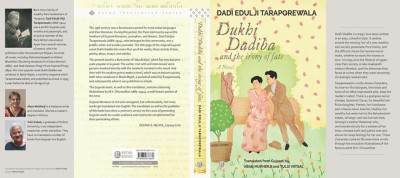Dukhi Dadiba and the irony of fate(Hardcover, DADI EDULJI TARAPOREWALA)
Quick Overview
Product Price Comparison
Dukhi Dadiba is a tragic love story written in an easy, colourful style. It centres around the missing heir of a very wealthy and socially prominent Parsi family, and the difficult choice the heroine has to make, whether to marry for money or love. It brings alive the lifestyle of upperclass Parsi society in late nineteenth century Mumbai, and the dilemmas they faced at a time when they were becoming increasingly westernized.TaraporewalaŌĆÖs vividly drawn characters, his true-to-life dialogues, the twists and turns of an often improbable plot, keep the readers riveted. There is a pompous social climber, Darashah Davar; his beautiful but fickle daughter, Pareen; her handsome and virtuous music teacher, Dadiba; the wealthy but weak heir to the Bahadurshah estate, Jehangir; and last but not least, JehangirŌĆÖs mother Ratanmai who, uncharacteristically for a woman of her time, chooses truth and justice over and above her deep feelings for her son. These characters come to life even more vividly through the evocative illustrations of the famous artist M.V. Dhurandhar.The 19th century was a Renaissance period for most Indian languages and their literature. During this period, the Parsi community was at the forefront of Gujarati literature, journalism, and theatre. Dadi Eduljee Taraporewala (1868ŌĆō1914), who belonged to this community, was a prolific writer and erudite journalist. The title page of the original Gujarati novel Dukhi Dadiba lists more than 30 of his works; these include fiction, poetry, plays, essays, and articles.The present novel is a forerunner of ŌĆśdocufictionŌĆÖ, which has now become quite popular in Gujarati. The author met with and interviewed some persons involved directly with the incidents narrated in the novel. And then with his creative genius wrote a novel, which was an instant success, both when serialized in Masik Majah, a periodical edited by Taraporewala, and subsequently when it was published as a book.The Gujarati novel, as well as this translation, contains charming illustrations by M.V. Dhurandhar (1867ŌĆō1944), a well-known painter of the time.Gujarati literature is rich and variegated, but unfortunately, not many works get translated into English. The translators as well as the publisher of this book have done a yeomanŌĆÖs service to the cause of presenting Gujarati works to a wider audience and need to be complimented for their painstaking efforts.DEEPAK B. MEHTA, Literary Critic


